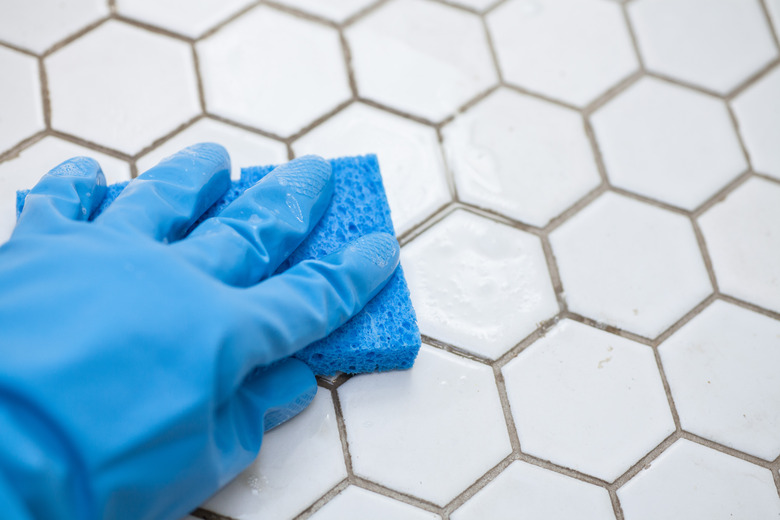How To Clean Tile Floors After Sewage Backup
We may receive a commission on purchases made from links.
Anyone who has done housecleaning knows the satisfaction of having a sparkling tile floor, even though the actual cleaning part feels like drudgery. When you have to clean tile floors after sewage has backed up into your house, running like Forrest Gump out the front door and never returning starts to sound like a pretty good idea.
Take off your Nikes, bite the bullet and get to work. Cleaning tile floors after a sewage backup is easy when a limited quantity of waste comes up from a basement drain and remains contained in one location. It'll be over before you know it if you're armed with the right supplies and if you're informed about the proper steps to take.
Causes and Dangers of Backups
Causes and Dangers of Backups
Sewage can back up into your home when the city's sanitary sewer system can't handle excessive rain or snowmelt events, when pipes fail in a compromised system or when pipes are clogged with foreign materials. Pipes running between your house and the main sewer line or pipes within your home also become clogged by grease buildup or by the flushing of items like paper towels, feminine hygiene products, single-use wipes and objects flushed by experimenting toddlers.
Sewage water contaminated with raw sewage can carry viruses, bacteria and parasitic organisms. You can be infected by eating or drinking after failing to clean your hands or through contact with cuts. Sewage can also produce airborne contamination, such as mold and fungi. Resulting issues may include asthma or life-threatening illnesses, such as dysentery, cholera, infectious hepatitis or potentially severe gastroenteritis.
Should You Clean It Yourself?
Should You Clean It Yourself?
The volume of sewage backup that comes from, say, a flooded city sewer can penetrate your home's structure and furnishings, requiring a very involved remediation plan. Sometimes, though, a limited quantity of waste coming from a clogged home sewer pipe is deposited locally where it shouldn't be, remaining contained in one location without penetrating your home's structure. If you have a finished basement with floor tile and experience a minor backup into a shower or bathroom drain, cleanup will be easy. Just make sure no absorbent materials — which can't be sanitized — are involved.
Cleaning the Affected Tile
Cleaning the Affected Tile
Take care not to touch contaminated surfaces, the wastewater or fecal matter with your bare hands while cleaning. Avoid touching open cuts or sores or your eyes, ears and nose during the cleanup. Do not eat or drink.
After you've called your local sewer authority to rule out a more serious cause and possibly your plumber to determine the source of the problem, you can start the cleanup, which for a small sewage backup will simply involve water extraction, washing and disinfecting.
1. Gather
Supplies and Gear
Even for simply cleaning tile after a minor backup, you should wear a respirator, rubber gloves, protective goggles and footwear that can either be tossed or completely cleaned and disinfected afterward. The cleaning supplies you'll need will include a wet/dry vacuum, trash bags, bucket, mop, sponges, a supply of cleaning cloths or old towels, low-suds household detergent and household bleach.
2. Ventilate the Area
Open basement windows for ventilation and use fans during and after the use of cleaning products.
3. Toss Absorbent Items
Throw out any absorbent items that were on the floor and in contact with the contaminated water.
4. Remove Waste Matter
If your minor backup did include the depositing of solid or semisolid waste matter, manually remove it, secure it in trash bags and call your local solid waste agency for instructions on proper disposal.
5. Extract Standing Wastewater
Remove any standing wastewater. If your affected floor area is small, you can simply wipe it up with old towels or cloths. For a greater area, you can use your wet/dry vacuum, which will then need to be discarded. If you rent a unit, you'll have to state what you're using it for.
6. Do a Preliminary Disinfection
Use a spray disinfectant over the area to initially reduce and contain the spread of microorganisms. Leave the product on the floor for the length of time recommended by the manufacturer before continuing to clean.
7. Wash the Tile Floor
Using a mop or sponge — whichever works well for the area to be covered — clean the tile floor with a mixture of warm or hot water and household detergent. To avoid cross-contamination, change your wash water and rinse water frequently while wiping or mopping.
8. Disinfect the Tile
Allow the floor to visibly dry and then, using an unused mop or sponge, go over the area with a mixture of 1/4 cup of chlorine bleach to a gallon of water to disinfect. Let it stay in contact with the floor for at least one minute.
9. Do a Second Wash
Rinse the floor well, wash again with detergent and water and then thoroughly rinse again.
10. Thoroughly Dry the Tile
Use electric fans to thoroughly dry the floor. If the amount of wastewater deposited warrants it, you can also close your windows and run a dehumidifier to help fully dry the tile.
References
- Ohio Environmental Protection Agency: Sewage Back Up During Rain Events
- United States Environmental Protection Agency: Sanitary Sewer Overflows
- University of Michigan Environment, Health & Safety: Suggested Guidelines for Remediation of Damage From Sewage Backflow Into Buildings
- Rytech: Sewage Cleanup: Not Your Typical Water Damage Situation
- United States Environmental Protection Agency: Flood-Related Cleaning
- Indiana State Department of Health: Homeowner Guidance on Cleaning Up After Residential Sanitary Sewer Backups
- InspectAPedia: Sewage Backup Clean-up Procedures & Standards
